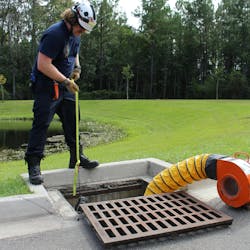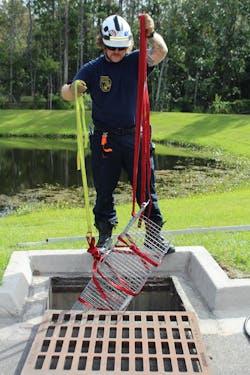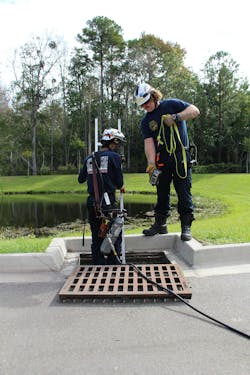Animal Rescues: Is the Duckling in the Drain the Modern Canary in the Coal Mine?
The image of a firefighter sporting a toothy grin with hands cupped around a fluffy kitten is a public information officer’s surefire way to garner community support and goodwill on social media. Although the stakes are lower compared with a human rescue, an animal rescue nevertheless tugs at the heartstrings. Too often, however, these goodwill opportunities appear to miss some critical elements that one day could turn great public relations outreach into a potential line-of-duty injury or even death—a tragedy that we have the ability, and the duty, to prevent.
Although some departments that have hazmat and special operations teams often use an animal rescue call as an opportunity to pull out specialized equipment and to employ skills that were developed in training, other departments sometimes send personnel down in bunker gear without respiratory protection, monitoring or retrieval considerations.
The old “canary in a coal mine” idiom could be swapped with a modern update: “duckling in a drain.” Animal vocalizations, whether a song or a quack, aren’t a good measure of air quality. Social media photographs reveal a recent history of firefighters who have little protection (save for their bunker pants) descending a ladder into a sewer drain to retrieve an animal victim. These successes usually are rewarding: The effort is low, a life is saved, and public adoration is granted to the team members who were involved. Although current reports don’t provide substantial data to demonstrate injuries or illnesses that occurred from these actions, the potential certainly is present. Complacency kills, and we can’t afford to lose one person to an incident that we have the ability to prevent.
Bad atmosphere
Permit-required confined spaces, as defined by the Occupational Safety and Health Administration, are those that can be entered bodily to perform work, have limited access and egress, and aren’t designed for continuous human occupancy. An additional concern is having one or more conditions that are hazardous to the health and safety of an entrant, including potential for bad atmosphere, engulfment, and internal physical or mechanical hazards.
Depending on local infrastructure, septic tanks might be more common than sewers in some areas. Storm drains that aren’t associated with sewers might appear to be less hazardous. However, depending on the use of fertilizers in the area, roadway spills and the presence of natural gas pipelines, the potential for bad atmosphere still might be significant.
Without appropriate monitoring, there can be no assurance that the space is or will remain safe for personnel to enter.
NFPA standards for confined space call for continuous air quality monitoring (or, minimally, at frequent intervals). The American National Standards Institute calls for the use of fresh-air breathing apparatus when making entry to a space where atmospheric hazards might be present. Respiratory protection is of utmost importance in the fire service, so why is this critical safety element so frequently neglected when it comes to entry into a storm drain or the like for a small animal?
When entry is required, the tactics on scene should include respiratory protection, unless it can be made certain that there’s no potential for hazardous atmosphere. Monitoring the air for oxygen, flammability and toxicity better informs the team of hazards that are present in the space. If entry can be made with a fresh-air breathing apparatus, this is ideal.
Bites, scratches & disease
A variety of tactics can make management of these incidents less hazardous for personnel.
Bite, scratch and zoonotic disease hazards are always present when making direct contact with an animal patient. Using extended reach tools is a natural first choice regardless of concern for atmospheric hazards. Nets that have long handles are a great tool for capturing many species of small animals. Baits and lures might be used to encourage animals to position themselves in a more accessible location for capture. Humane live traps can be baited, lowered and retrieved without directly contacting the animal or requiring entry of a rescuer.
If making direct contact with an animal patient, consider management of bite and scratch hazards. Animals that are in an emergency situation might be aggressive or defensive based on fear that’s associated with the environment, injuries that they sustained and concern about the potential predator that’s approaching in bunker gear.
Even small animals can deliver big injuries. The infections that might arise from bites or scratches, particularly those that are sustained while in polluted or contaminated environments, can be significant. Even thick gloves might not afford adequate protection from sharp teeth and claws.
Getting head control on a dog by using a slip lead (or improvising one by girth-hitching a length of 1-inch webbing) allows a rescuer some amount of control of movement of an animal. Smaller animals and those that aren’t accustomed to leash-walking might be able to be contained temporarily using a similar tactic, incorporating a front limb through the loop along with the head and neck to avoid injuries from airway occlusion. Luring or placing the animal in a hard-sided carrier or even a cloth sack can provide a safer way to transport the animal out of the space.
Connect with animal services
Following up rescue efforts with a mild dish soap decontamination bath at the earliest possible opportunity provides a better prognosis for the patient.
Departments should make connections proactively with their local animal services department, so when these emergencies occur, the involved animals can be relocated off the scene in accordance with local laws. Many areas require a specific holding time for a lost animal, to allow its owner the chance to reclaim it. If no owner comes forward, the same social media posts that promote the hard work and training of a department might encourage potential adopters to come forward.
Lead by example
Fire departments can, and should, capitalize on animal rescue operations. Not only does this work provide an enhanced training opportunity, but there also is value in demonstrating scene safety to the public. If the fire department doesn’t do these rescues the correct way, citizens might attempt to perform them in more dangerous ways. Leading by example and educating the community about these hazards might mean the difference between successfully performing an animal rescue or a human rescue or failing.
Finally, do you know that Code 542 for animal rescue in the National Fire Incident Reporting System (NFIRS) can help you to better track responses for animal rescues. Share this code with your crews to help the fire service get better data to monitor the frequency and type of calls that are associated with animal emergency response.
About the Author

Brandi Phillips
Brandi Phillips serves as the Animal Technical Rescue Branch Director for the University of Florida Veterinary Emergency Treatment Service (UF VETS). In this role, she provides training to fire department personnel as well as other public safety and livestock stakeholders throughout the state of Florida. In addition to animal technical rescue response, Phillips and the UF VETS team provide veterinary disaster response for major incidents that affect the state of Florida. Phillips also has served on the NFPA 1006 and NFPA 2500 committees since 2018.


